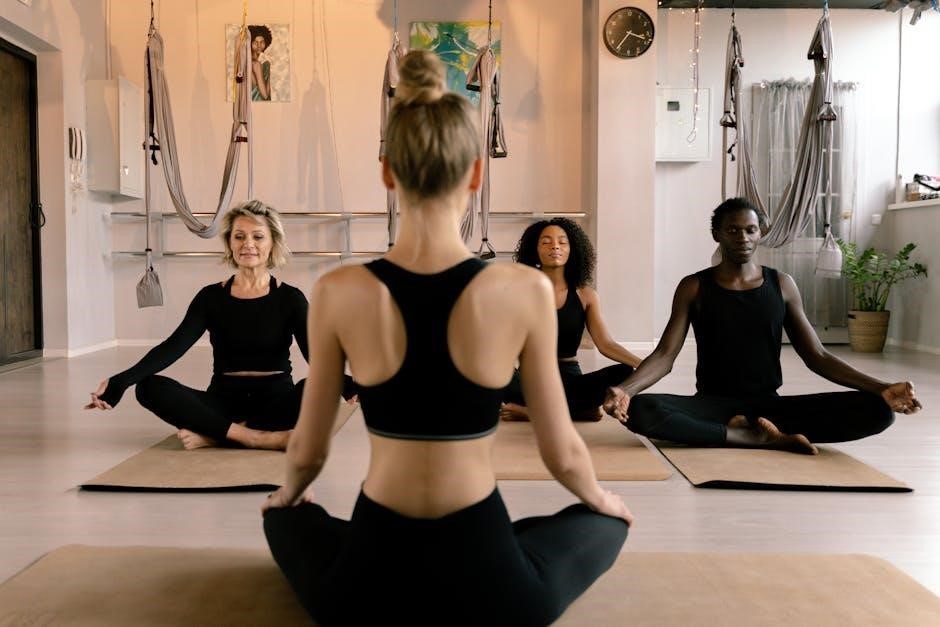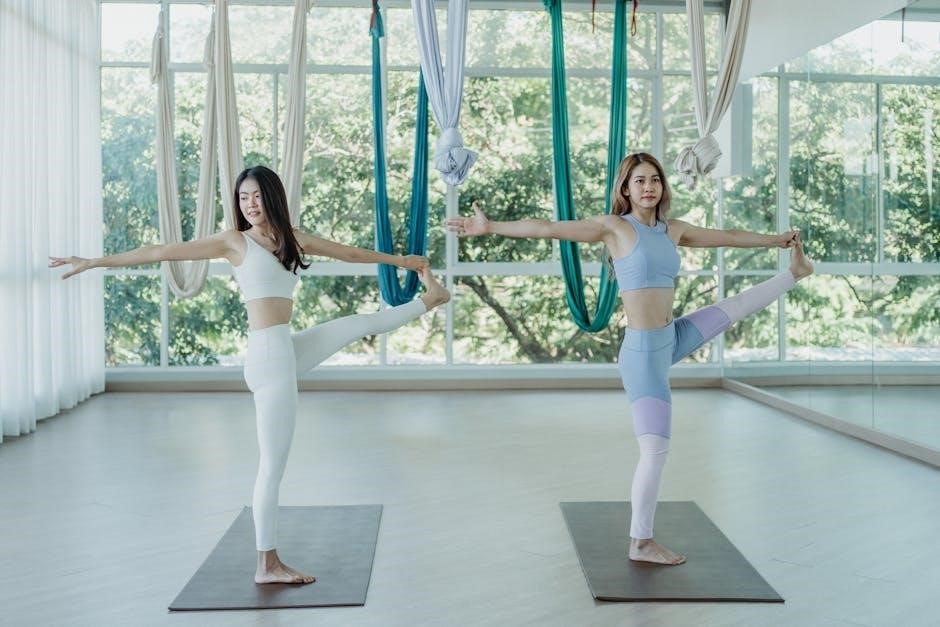60-Minute Yin Yoga Sequence: A Comprehensive Guide
Embark on a transformative journey with our comprehensive guide to a 60-minute Yin Yoga sequence. Discover how this gentle practice can unlock flexibility‚ reduce stress‚ and promote deep relaxation. Explore the key poses and principles that make Yin Yoga so effective for physical and mental well-being.
Yin Yoga‚ a gentle and meditative practice‚ distinguishes itself by focusing on long-held stretches that target the body’s deep connective tissues‚ such as ligaments‚ joints‚ and fascia. Unlike more active forms of yoga‚ Yin Yoga emphasizes stillness and passive stretching‚ allowing practitioners to cultivate a deeper sense of body awareness and inner peace.
This practice is particularly effective for releasing tension and promoting flexibility‚ making it an ideal complement to more dynamic “yang” styles of exercise. By holding poses for extended periods‚ typically three to five minutes‚ Yin Yoga encourages the body to release deeply held tension and emotional blockages‚ fostering a sense of profound relaxation and well-being.
The benefits of Yin Yoga extend beyond the physical realm‚ offering a powerful tool for stress reduction and mental clarity. The meditative nature of the practice encourages practitioners to turn inward‚ observing their thoughts and sensations without judgment. This can lead to increased self-awareness and a greater ability to manage stress and anxiety.
Whether you’re a seasoned yogi or new to the practice‚ Yin Yoga offers a gentle and accessible path to improved flexibility‚ reduced stress‚ and enhanced overall well-being. A 60-minute Yin Yoga sequence provides a comprehensive and effective way to experience the transformative benefits of this ancient practice.
Benefits of a 60-Minute Yin Practice
A dedicated 60-minute Yin Yoga practice offers a wealth of benefits that extend far beyond simple stretching. Primarily‚ it profoundly enhances flexibility by targeting deep connective tissues‚ promoting a greater range of motion in joints and alleviating stiffness. This is particularly beneficial for athletes‚ runners‚ or individuals who spend extended periods sitting.
Furthermore‚ Yin Yoga excels at stress relief and relaxation. The extended holds encourage the release of tension held within the body‚ promoting a sense of calm and grounding. The meditative aspect of the practice allows for introspection and mindful awareness‚ helping to quiet the mind and reduce anxiety.
Beyond the physical and mental benefits‚ Yin Yoga can also improve sleep quality. By releasing tension and promoting relaxation‚ it can ease the transition into sleep and improve overall sleep duration. Additionally‚ it can contribute to improved circulation as the long holds encourage blood flow to areas that may be restricted.

Finally‚ a 60-minute Yin practice provides an opportunity to cultivate self-awareness and body acceptance. The focus on internal sensations and mindful observation encourages a deeper connection to one’s body‚ fostering a sense of appreciation and respect.

Key Principles of Yin Yoga

Yin Yoga distinguishes itself through several core principles that guide its practice. First and foremost is the principle of edge. This involves finding an appropriate depth in each pose‚ one that offers sensation without causing pain or strain. It’s about respecting your body’s limits and listening to its feedback‚ modifying poses as needed.
The second principle is resolve to remain still. Once you’ve found your edge‚ the aim is to stay relatively still for the duration of the pose‚ typically 3-5 minutes. This stillness allows the connective tissues to be gently stressed and lengthened.
The third principle is rebound. After each pose‚ taking a few moments of stillness in a neutral position allows you to observe the effects of the pose on your body and mind. This rebound period is an integral part of the practice‚ allowing for integration and restoration.
Finally‚ it’s essential to approach Yin Yoga with mindfulness. Paying attention to your breath‚ sensations‚ and thoughts without judgment is key. This mindful awareness helps you stay present in the moment and deepen your connection to your body.
Sample 60-Minute Yin Yoga Sequence
This sequence provides a framework for a 60-minute Yin Yoga practice. Remember to listen to your body and modify poses as needed. Begin with a few minutes of centering and breath awareness to settle into the practice. Follow with Butterfly Pose (3 minutes)‚ gently opening the hips. Transition into Dragonfly Pose (3 minutes)‚ further stretching the inner thighs and hamstrings;
Next‚ move into Child’s Pose (3 minutes) for a gentle back stretch and grounding. Then‚ proceed to Melting Heart Pose (3 minutes)‚ targeting the shoulders and upper back. From here‚ flow into Sphinx Pose (3 minutes) for a gentle backbend‚ followed by Seal Pose (3 minutes) for a deeper backbend.
Continue with Caterpillar Pose (3 minutes) for a deep forward fold‚ and then Reclined Twist (3 minutes per side) to release tension in the spine. Incorporate Banana Pose (3 minutes per side) for a lateral stretch. Finally‚ conclude with Savasana (5-10 minutes) for complete relaxation and integration.
Melting Heart Pose (Anahatasana)
Melting Heart Pose‚ also known as Anahatasana‚ is a deeply restorative Yin Yoga posture that gently opens the shoulders‚ chest‚ and upper back. It is similar to Puppy Pose in more active (yang) styles of yoga‚ but with a greater emphasis on surrender and relaxation. To enter the pose‚ begin on your hands and knees in a tabletop position.
Slowly walk your hands forward‚ allowing your chest to melt towards the floor. Keep your hips stacked over your knees‚ maintaining a 90-degree angle. You can rest your forehead on the floor or a block‚ or gently tuck your chin towards your chest for a deeper neck stretch. Breathe deeply and allow gravity to assist in opening the chest and shoulders.
Hold the pose for 3-5 minutes‚ focusing on releasing any tension in the upper body. This pose is particularly beneficial for relieving stress‚ improving posture‚ and fostering feelings of compassion and openness. To exit‚ slowly walk your hands back towards your body and return to a neutral tabletop position.
Banana Pose Breakdown
Banana Pose is a simple yet profound side-bending posture in Yin Yoga that targets the connective tissues along the side body‚ particularly the intercostal muscles and the fascia surrounding the ribs. It’s generally well-received due to its accessibility and minimal contraindications‚ making it suitable for most practitioners.
To begin‚ lie flat on your back with your arms extended overhead. Shift your upper body and legs to the right‚ creating a gentle crescent shape with your body‚ resembling a banana. You can deepen the stretch by crossing your left ankle over your right ankle and gently holding your left wrist with your right hand.
Focus on maintaining a comfortable stretch along the left side of your body‚ avoiding any sharp or painful sensations. Breathe deeply and allow gravity to encourage the side bend. Hold the pose for 3-5 minutes‚ then slowly return to the center before repeating on the opposite side. Banana Pose helps release tension in the side body and promote a sense of expansion.
Yin Yoga for Stress Relief and Relaxation
Yin Yoga’s unique approach‚ characterized by long-held‚ passive poses‚ makes it a powerful tool for stress relief and deep relaxation. Unlike more active styles of yoga‚ Yin focuses on stimulating the parasympathetic nervous system‚ often referred to as the “rest and digest” system. By holding poses for extended periods‚ typically 3-5 minutes‚ we create an opportunity for the body to release tension stored in the fascia‚ the connective tissue that surrounds our muscles and organs.
This deep release has a profound calming effect on the mind‚ promoting a sense of peace and tranquility. The meditative aspect of Yin Yoga further enhances its stress-reducing benefits. As we surrender to the poses‚ we learn to observe our thoughts and sensations without judgment‚ cultivating mindfulness and emotional resilience.
A regular Yin practice can help regulate the nervous system‚ reduce anxiety‚ and improve sleep quality. The combination of physical release and mental stillness makes Yin Yoga an ideal practice for those seeking to unwind and find inner peace in today’s fast-paced world.

Yin Yoga for Hip Opening
Yin Yoga is particularly effective for hip opening due to its focus on long-held‚ passive stretches that target the deep connective tissues surrounding the hip joints. Many of us accumulate tension in our hips from prolonged sitting‚ physical activity‚ or emotional stress. This tension can restrict mobility and contribute to discomfort in the lower back and legs.
Yin Yoga offers a gentle yet powerful way to release this tension and improve hip flexibility. Poses like Butterfly‚ Dragonfly‚ and Square Pose are specifically designed to target the hip flexors‚ adductors‚ and external rotators. By holding these poses for several minutes‚ we allow the connective tissues to soften and lengthen‚ increasing range of motion and promoting greater ease of movement.
The practice also encourages a deeper awareness of the body‚ allowing us to identify and release areas of holding. Regular Yin Yoga practice can lead to significant improvements in hip mobility‚ reducing pain and stiffness while enhancing overall well-being. It is a safe and effective way to nurture and care for your hips.
Creating Your Own Yin Sequence
Crafting your own Yin Yoga sequence allows for personalized practice tailored to your specific needs and preferences. Start by identifying areas in your body that feel tight or restricted‚ such as the hips‚ shoulders‚ or spine. Select poses that target these areas‚ considering variations and modifications to suit your flexibility level.
A balanced sequence should include a mix of forward folds‚ backbends‚ and twists to address different aspects of the body. Incorporate poses that promote both physical and emotional release‚ as Yin Yoga can be a powerful tool for stress reduction. Remember to hold each pose for an extended period‚ typically 3-5 minutes‚ allowing the connective tissues to soften and release.
Pay attention to your breath throughout the practice‚ using it as an anchor to stay present and deepen into the poses. Create a calming atmosphere with soft lighting and soothing music to enhance the relaxation experience. With mindful planning‚ you can design a Yin Yoga sequence that nourishes your body‚ calms your mind‚ and promotes overall well-being.
Resources for Yin Yoga Sequences and PDFs
Seeking inspiration and guidance for your Yin Yoga journey? Numerous resources are available to help you discover pre-designed sequences and downloadable PDFs. Online platforms like Tummee offer extensive libraries of yoga sequences‚ including specialized Yin Yoga routines tailored to different needs and levels. These platforms often provide detailed cues and modifications to ensure safe and effective practice.
Many yoga instructors and studios also offer free or paid Yin Yoga sequence PDFs on their websites or through newsletters. These resources can be a valuable starting point for beginners or a source of fresh ideas for experienced practitioners. Additionally‚ explore yoga books and magazines that often feature sample Yin Yoga sequences with step-by-step instructions and illustrations.
Websites dedicated to yoga therapy may also provide specialized sequences designed to address specific conditions such as back pain or anxiety. Remember to consult with a qualified yoga instructor or healthcare professional before starting any new yoga practice‚ especially if you have underlying health concerns. With a wealth of resources at your fingertips‚ you can easily find Yin Yoga sequences and PDFs to support your practice and deepen your understanding of this transformative style of yoga.
